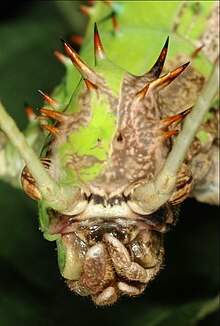Gynander

Gynandromorphism (Greek gyne, gen. Gynaikos - woman; aner, gen. Andros - man), also half-sided hermaphrodite or gynander , denotes organisms in whose bodies both male and female cells occur due to errors in early embryonic cell division .
Occurrence and origin
In insects , especially butterflies , beetles and flies , the decision about gender as well as gender-specific differentiation is cell-autonomous and not, as is the case with many organisms, determined by the hormonal environment. This means that a cell with a female genome develops into a female cell and vice versa. If a non-disjunction , i.e. a non-separation of the homologous gonosomes , occurs in the mitotic cell reproduction during the development of the embryo of a female , male cells and female cells arise, which are then further reproduced mitotically. The earlier in development such somatic non-disjunctions take place, the larger the areas that are male or female. If such an aneuploidy already takes place in the metaphase , the first mitotic division of the zygote , then the rare half-sided hermaphrodites arise; in a later phase of embryogenesis , only smaller areas are affected (wings, head, thorax, etc.).
It can also be observed in birds , e.g. B. in ducks and finches; but not with humans.
Web links
- www.lepiforum.de: Gynanderomorphism in butterflies
- Half male, half female butterfly steals the show at Natural History Museum in The Guardian on July 12, 2011; Retrieved August 6, 2011
Individual evidence
- ↑ Gynander Among Birds - Neither Rooster nor Hen. In: vogelundnatur.de. September 3, 2014, accessed January 7, 2017 .
- ↑ Sexual hybrid: Two-part finch fascinates researchers. In: Spiegel Online . March 25, 2003, accessed January 7, 2017 .

